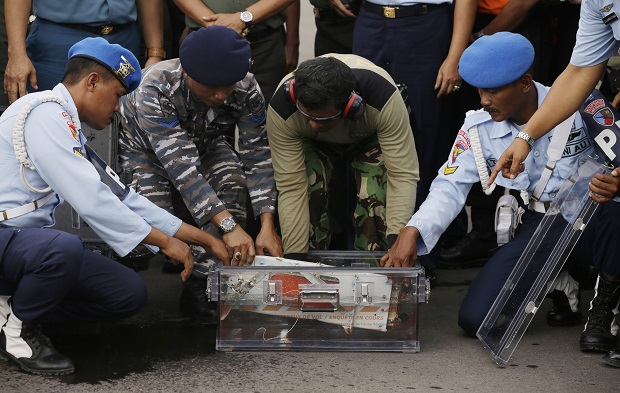
Indonesian air force and Indonesian navy personnel hold Flight Data Recorder of the ill-fated AirAsia Flight 8501 that crashed in the Java Sea, at airport in Pangkalan Bun, Indonesia, Monday, Jan. 12, 2015. Divers retrieved one black box Monday and located the other from the AirAsia plane that crashed more than two weeks ago, a key development that should help investigators unravel what caused the aircraft to plummet into the Java Sea. AP
NEW YORK, United States — Investigators trying to figure out why AirAsia Flight 8501 crashed into the Java Sea on Dec. 28 might now have the tools they need to provide answers.
On Monday the flight’s data recorder was pulled up from the bottom of the shallow sea. The cockpit voice recorder was also located but not yet surfaced. It could take up to two weeks to analyze all the data on the so-called black boxes. Based on past crashes, the information retrieved could be vital.
The two separate devices — actually orange boxes designed to survive extreme heat and pressure — should provide investigators with a second-by-second timeline of the plane’s flight.
The voice recorder takes audio feeds from four microphones within the cockpit and records all the conversations between the pilots, air traffic controllers as well as any noises heard in the cockpit. That could be alarms going off or loud explosions. It records on a two-hour loop, so investigators here won’t just capture the plane’s final minutes but the entire 42-minute trip.
The flight data recorder captures 25 hours’ worth of information on the position and condition of almost every major part in a plane.
Some of the major items recorded include: altitude, airspeed, what rate the plane is climbing or descending, what direction of the compass it was flying toward, what angle up or down it was pointed, if the plane was leaning to the left or the right, the thrust of the engines, rate at which fuel was flowing to them, pressure in the hydraulic lines and the position of the flaps, rudder and landing gear.
While it could take up to two weeks to analyze all the data, investigators shouldn’t have any problems reading it. The boxes are designed to withstand a 2,012-degree fire lasting 30 minutes, then a 500-degree fire lasting 10 hours as well as pressure from sea depths of up to 20,000 feet.
In past crashes, the flight data and cockpit data recorders have provided key information for investigators.
When Asiana Airlines Flight 214 landed short of the runway in San Francisco in 2013, it was the data recorder that showed that pilots had let the plane fall well below its normal landing speed and that they realized this mistake only seconds before touching down when they tried to speed up.
The black boxes were even more important to figuring out what happened to Air France Flight 447, which disappeared over the Atlantic Ocean while flying from Rio de Janeiro to Paris in 2009. Investigators were ultimately able to pull them from the depths of the ocean and learn about mistakes the pilots made after their plane went into an aerodynamic stall.
In the background of the frenzied conversation, computer-generated voices can be heard warning “Stall. Stall. Stall.” The alarm sounded numerous times during the flight’s final minutes.
The chilling transcript also includes moments like one of the pilots saying: “I don’t understand what’s happening.” Seconds later, the other pilot says: “Damn it, I don’t have control of the plane, I don’t have control of the plane at all.”
RELATED STORIES
Divers retrieve AirAsia flight data recorder
2nd black box found under AirAsia wreckage